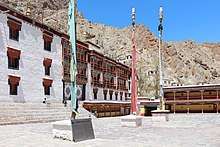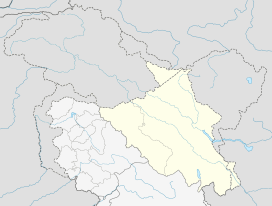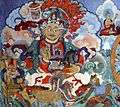Hemis Monastery
Hemis Monastery is a Himalayan Buddhist monastery (gompa) of the Drukpa Lineage, in Hemis, Ladakh, India. Situated 45 km from Leh, the monastery was re-established in 1672 by the Ladakhi king Sengge Namgyal. The annual Hemis festival honouring Padmasambhava is held in early June.
| Hemis Monastery | |
|---|---|
 Hemis Monastery | |
| Religion | |
| Affiliation | Tibetan Buddhism |
| Sect | Drukpa |
| Leadership | The Twelfth Gyalwang Drukpa |
| Location | |
| Location | Ladakh, India |
| Country | India |
 Location within Ladakh, India | |
| Geographic coordinates | 33°54′44.91″N 77°42′10.2″E |
| Architecture | |
| Style | Tibetan Architecture |
| Founder | Sengge Namgyal |
.jpg)
History
Hemis Monastery existed before the 11th century. Naropa, the pupil of the yogi Tilopa, and teacher of the translator Marpa is connected with this monastery. A translation was made by A. Grünwedel (Năro und Tilo,: Festschrift Ernst Kuhn, München 1916) of Naropa's biography that was found in Hemis monastery.
In this manuscript Naropa (or Naro) meets the "dark blue" (Skr.: nila: dark blue or black) Tilopa (or Tillo), a tantric master, who gives Naropa 12 "great" and 12 "small" tasks to do in order to enlighten him to the inherent emptiness/illusoriness of all things. Naropa is depicted as the "abbott of Nalanda" (F. Wilhelm, Prüfung und Initiation im Buche Pausya und in der Biographie des Naropa, Wiesbaden 1965, p. 70), the university-monastery in today's Bihar, India, that flourished until the sacking by Turkish and Afghan Muslim forces. This sacking must have been the driving force behind Naropa's peregrination in the direction of Hemis. After Naropa and Tilopa met in Hemis they travelled back in the direction of a certain monastery in the now no longer existing kingdom of Magadha, called Otantra which has been identified as today's Odantapuri. Naropa is considered the founding father of the Kagyu-lineage of the Himalayan esoteric Buddhism. Hence Hemis is the main seat of the Kagyu lineage of Buddhism.
In 1894 Russian journalist Nicolas Notovitch claimed Hemis as the origin of an otherwise unknown gospel, the Life of Saint Issa, Best of the Sons of Men, in which Jesus is said to have traveled to India during his "lost years." According to Notovitch, the work had been preserved in the Hemis library, and was shown to him by the monks there while he was recuperating from a broken leg.[1] But once his story had been re-examined by historians, it is claimed that Notovitch confessed to having fabricated the evidence.[2][3] The controversial bible scholar Bart D. Ehrman states that "Today there is not a single recognized scholar on the planet who has any doubts about the matter. The entire story was invented by Notovitch, who earned a good deal of money and a substantial amount of notoriety for his hoax".[4]
The Indian Pandit Swami Abhedananda also claims to have read the same manuscript, and published his account of viewing it after his visit to Hemis in 1921.[5] Abhedananda claims on the book jacket that it was translated for him with the help of a "local Lama interpreter." However, after Abhedananda's death, one of his disciples admitted that when he went to the monastery to ask about the documents he was told that they had disappeared.[6] In the same vein, Notovich did not initially translate the manuscript, but reported his Sherpa guide did so as Notovitch could not read the original text.[7] Notovich's version of the manuscript was translated from Tibetan to Russian to French to English. According to Swami Abhedananda's account, his Lama's translation was equivalent to the one published by Notovich. The Gutenberg Project has published the entire manuscript as a free ebook.[8]
Hemis Festival
The Hemis Festival is dedicated to Lord Padmasambhava (Guru Rinpoche) venerated as the Dance Performance at Hemis Monastery representative reincarnate of Buddha. He is believed to have been born on the 10th day of the fifth month of the Monkey year as predicted by the Buddha Shakyamuni. It is also believed that his life mission is was, and remains, to improve the spiritual condition of all living beings. And so on this day, which comes once in a cycle of 12 years, Hemis observes a major extravaganza in his memory. The observance of these sacred rituals is believed to give spiritual strength and good health. The Hemis festival takes place in the rectangular courtyard in front of the main door of the monastery. The space is wide and open save two raised square platforms, three feet high with a sacred pole in the center. A raised dais with a richly cushioned seat with a finely painted small Tibetan table is placed with the ceremonial items - cups full of holy water, uncooked rice, tormas made of dough and butter and incense sticks. A number of musicians play the traditional music with four pairs of cymbals, large-pan drums, small trumpets and large size wind instruments. Next to them, a small space is assigned for the lamas to sit.
The ceremonies begin with an early morning ritual atop the Gompa where, to the beat of drums and the resounding clash of cymbals and the spiritual wail of pipes, the portrait of "Dadmokarpo" or "Rygyalsras Rinpoche" is then ceremoniously put on display for all to admire and worship.
The most esoteric of festivities are the mystic mask dances. The Mask Dances of Ladakh are referred collectively as chams Performance. Chams performance is essentially a part of Tantric tradition, performed only in those gompas which follow the Tantric Vajrayana teachings and the monks perform tantric worship.
 Hemis Monastery in Ladakh, by Vasily Vereshchagin (1875)
Hemis Monastery in Ladakh, by Vasily Vereshchagin (1875) The entrance of Hemis monastery
The entrance of Hemis monastery Inside the Hemis Monastery
Inside the Hemis Monastery Mural painting in the Hemis monastery
Mural painting in the Hemis monastery Traditional Monk Dance at Hemis Festival
Traditional Monk Dance at Hemis Festival Traditional Ladakhi Womens at Hemis Monastery
Traditional Ladakhi Womens at Hemis Monastery
Footnotes
| Part of a series on |
| Tibetan Buddhism |
|---|
 |
|
|
|
Practices and attainment |
|
Institutional roles |
|
History and overview |
- Nicolas Notovitch (1907). The Unknown Life Of Jesus Christ, Chikago: Progressive Thinker Pub. House
- New Testament Apocrypha, Vol. 1: Gospels and Related Writings by Wilhelm Schneemelcher and R. Mcl. Wilson (1 December 1990) ISBN 066422721X page 84 "a particular book by Nicolas Notovich (Di Lucke im Leben Jesus 1894) ... shortly after the publication of the book, the reports of travel experiences were already unmasked as lies. The fantasies about Jesus in India were also soon recognized as invention... down to today, nobody has had a glimpse of the manuscripts with the alleged narratives about Jesus"
- Indology, Indomania, and Orientalism by Douglas T. McGetchin (1 January 2010) Fairleigh Dickinson University Press ISBN 083864208X page 133 "Faced with this cross-examination, Notovich confessed to fabricating his evidence."
- Ehrman, Bart D. (February 2011). "8. Forgeries, Lies, Deceptions, and the Writings of the New Testament. Modern Forgeries, Lies, and Deceptions". Forged: Writing in the Name of God—Why the Bible's Authors Are Not Who We Think They Are (EPUB)
|format=requires|url=(help) (First Edition. EPub ed.). New York: HarperCollins e-books. pp. 282–283. ISBN 978-0-06-207863-6. Retrieved 8 September 2011. - Swami Abhedananda's "Journey Into Kashmir and Tibet" rendered into English by Ansupati Dasgupta and Kunja Bihari Kundu. http://www.exoticindiaart.com/book/details/swami-abhedananda-s-journey-into-kashmir-and-tibet-IDJ093/
- Hooper 2012, p. 176.
- "The original scrolls brought from India to Nepaul, and from Nepaul to Thibet, relating to the life of Issa, are written in the Pali language and are actually in Lhassa; but a copy in our language—I mean the Thibetan—is in this convent." https://www.gutenberg.org/files/29288/29288-h/29288-h.htm
- The Project Gutenberg eBook, The Unknown Life of Jesus Christ, by Nicolas Notovitch, Translated by J. H. Connelly and L. Landsberg. https://www.gutenberg.org/files/29288/29288-h/29288-h.htm
References
- Francke, A. H. (1914, 1926). Antiquities of Indian Tibet. Two Volumes. Calcutta. 1972 reprint: S. Chand, New Delhi.
External links
| Wikimedia Commons has media related to Hemis Monastery. |